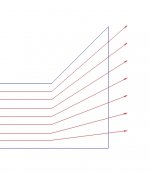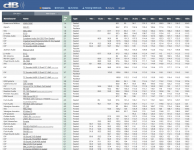(main pain = shoulder muscles are gone - shoulder's locked - costochondritis in sternum - plus reflux/vertigo/apnea issues - ouch - feels like I'll have a heart attack just to move)
Last edited:
Looks they are all medical symptoms, what you mention, not a reasonable cause. I like to watch The Incurables on Cable Tv. Hope you get better. Send PM if you feel like.
Thanks for the explanation Dave, I got it. Venturi stacks are more effective as intakes, exhaust is irrelevant in the application I had in mind. I didn't consider how air would react upon exiting.
Airflow is affected when it flows in either direction.
It just takes a certain velocity, dependent on the port geometry, before it will trip to turbulent flow if the flare is to severe( too big of a radius).
Angles work way better.
Also a 45 degree one sided flare, like one may put on the outlet of s slot port where one wall is the outside wall of the box will work just as good as 2- 22.5 degree flares on either side of a port inlet or outlet.
See pic below.
45 flare.jpg
Dave
Attachments
Last edited:
If I plan on running my sub High output? SHould I port it?😕well.. pressure buildup especially if the box is sealed, not necessarily if the box is ported .. depends on how tight the space is and how much cone movement you are experiencing.
I kept it sealed for over a year so far.
 Sounds good sealed except very high SPL.
Sounds good sealed except very high SPL.Maybe get a second sealed Sub? If I like good Sound quality?
Last edited:
if you feel you need more SPL for louder listening, then the easy way is buy/build one or two extra bass only to match your existing.
One extra (with it's own amplifier) gives you ~ 3dB to 6dB extra bass and may require you to turn down the bass channel gain.
Two extra gives ~ 5dB to 9.5dB extra bass and will require you to turn down the bass channel gains.
One extra (with it's own amplifier) gives you ~ 3dB to 6dB extra bass and may require you to turn down the bass channel gain.
Two extra gives ~ 5dB to 9.5dB extra bass and will require you to turn down the bass channel gains.
I don't believe the flow around that corner can remain attached.
Sure it can. Point your subwoofer the other way and tell me you can't hear it.
Chris
the post43 corner showing the angled kink in the roof of the port.Sure it can. Point your subwoofer the other way and tell me you can't hear it.
Chris
Sadly I had to go sealed
Happy with the results amazing sub too large Tom move downstairs should had made a smaller one too .
Happy with the results amazing sub too large Tom move downstairs should had made a smaller one too .
Attachments
-
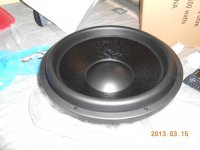 8A84B440-1B83-4F73-88DA-966B0EB35713.jpeg60.7 KB · Views: 89
8A84B440-1B83-4F73-88DA-966B0EB35713.jpeg60.7 KB · Views: 89 -
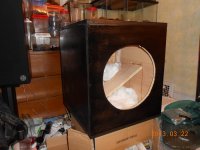 BC131BE1-39BF-492B-BF02-ADD107B12B3D.jpeg78.8 KB · Views: 85
BC131BE1-39BF-492B-BF02-ADD107B12B3D.jpeg78.8 KB · Views: 85 -
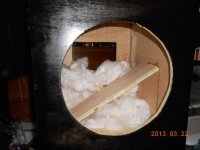 55E59B75-FC3C-4B56-9E5B-86CA203BB0BA.jpeg66 KB · Views: 82
55E59B75-FC3C-4B56-9E5B-86CA203BB0BA.jpeg66 KB · Views: 82 -
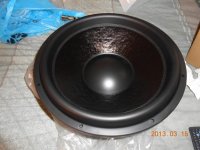 133D2AC8-3ADF-40AC-9D1B-2002FC54D10D.jpeg82.9 KB · Views: 92
133D2AC8-3ADF-40AC-9D1B-2002FC54D10D.jpeg82.9 KB · Views: 92 -
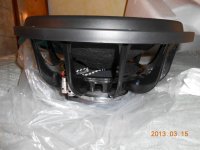 7D5CBC92-0C4D-4A6E-ADC1-20A1ADA5E4B5.jpeg76.1 KB · Views: 99
7D5CBC92-0C4D-4A6E-ADC1-20A1ADA5E4B5.jpeg76.1 KB · Views: 99 -
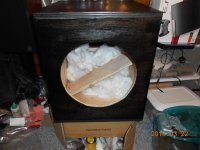 2A61B674-0DDC-4A80-834F-09A0D81B8C7C.jpeg83.1 KB · Views: 203
2A61B674-0DDC-4A80-834F-09A0D81B8C7C.jpeg83.1 KB · Views: 203 -
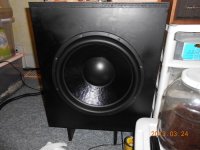 A7782CD8-BE50-4FC4-A611-050C2046C6B1.jpeg86.5 KB · Views: 207
A7782CD8-BE50-4FC4-A611-050C2046C6B1.jpeg86.5 KB · Views: 207 -
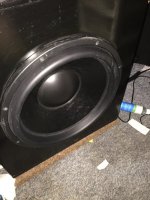 85B2FECF-9647-4AD0-80BD-FF4D7233C82B.jpeg59.8 KB · Views: 221
85B2FECF-9647-4AD0-80BD-FF4D7233C82B.jpeg59.8 KB · Views: 221
Last edited:
Sorry about your disappointment.
After reading specifications supplied for various subwoofer drivers, I noticed that they call for larger boxes when incorporating ports compared to sealed enclosures.
Personally I only like a sealed box that is stuffed with polyester batting. It should be small enough that the frequency response before the crossover point at around 180hz, or something you decide on, drops off in a steady line, for example, 12dB/octave. Then I use very large amounts of equalization to invert the roll-off slope. A high-excursion woofer (having a low free air resonance frequency) is important too. It also requires plenty of reserve power from the amplifier. In such a setup, I had my subwoofer well away from room boundaries, and I sat right next to it.
That's how I got exquisite (in my opinion) bass reproduction, especially bass guitar, with great percussion and flat response down to 30hz or lower.
After reading specifications supplied for various subwoofer drivers, I noticed that they call for larger boxes when incorporating ports compared to sealed enclosures.
Personally I only like a sealed box that is stuffed with polyester batting. It should be small enough that the frequency response before the crossover point at around 180hz, or something you decide on, drops off in a steady line, for example, 12dB/octave. Then I use very large amounts of equalization to invert the roll-off slope. A high-excursion woofer (having a low free air resonance frequency) is important too. It also requires plenty of reserve power from the amplifier. In such a setup, I had my subwoofer well away from room boundaries, and I sat right next to it.
That's how I got exquisite (in my opinion) bass reproduction, especially bass guitar, with great percussion and flat response down to 30hz or lower.
Last edited:
I seem to remember a specific example now.
Say the crossover point to the subwoofer is 180Hz. Have the speaker and sealed box chosen so that the response is already down 3dB at 180Hz. Natural roll-off slope of a speaker in a sealed box is about 6dB per octave (It's 12dB/octave for a ported box. That shows a big advantage for the sealed approach).
So it's response is -3dB at 180, -9dB at 90, -15dB at 45, and -21dB at 22.5 Hertz. Add in active equalization (of the electrical audio signal going to the subwoofer) that kind of flips that 6dB/octave slope. So, +3dB at 180, +9dB at 90, +15dB at 45, +21dB at 22.5
Also, it would be good to add in a brick wall high-pass filter beginning at about 20 Hertz.
Say the crossover point to the subwoofer is 180Hz. Have the speaker and sealed box chosen so that the response is already down 3dB at 180Hz. Natural roll-off slope of a speaker in a sealed box is about 6dB per octave (It's 12dB/octave for a ported box. That shows a big advantage for the sealed approach).
So it's response is -3dB at 180, -9dB at 90, -15dB at 45, and -21dB at 22.5 Hertz. Add in active equalization (of the electrical audio signal going to the subwoofer) that kind of flips that 6dB/octave slope. So, +3dB at 180, +9dB at 90, +15dB at 45, +21dB at 22.5
Also, it would be good to add in a brick wall high-pass filter beginning at about 20 Hertz.
Oh well forget all that calculating since I think the real roll-off for a sealed box is 12dB/octave (24dB /octave for ported).
Electrone,
The "real" roll-off for a sealed or ported boxes depends on the driver/box alignment, there are sealed boxes with near 24dB per octave roll off, and ported boxes near 12dB/octave roll off below Fb.
The examples below illustrate the variety, and are without the influence of room response.
Data-Bass: Subwoofer Measurements
Art
The "real" roll-off for a sealed or ported boxes depends on the driver/box alignment, there are sealed boxes with near 24dB per octave roll off, and ported boxes near 12dB/octave roll off below Fb.
The examples below illustrate the variety, and are without the influence of room response.
Data-Bass: Subwoofer Measurements
Art
Attachments
Hi Art,
Thanks for that interesting chart. I was thinking along the lines of the average slope in a rather linear portion of the response curve on the low side of the curve, away from a response peak or plateau, more like the slope along frequencies below f3, and also thinking of a very damped sealed enclosure.
I'm also thinking about infinite baffle and transmission line.
Thanks for that interesting chart. I was thinking along the lines of the average slope in a rather linear portion of the response curve on the low side of the curve, away from a response peak or plateau, more like the slope along frequencies below f3, and also thinking of a very damped sealed enclosure.
I'm also thinking about infinite baffle and transmission line.
I seem to remember a specific example now.
Say the crossover point to the subwoofer is 180Hz. Have the speaker and sealed box chosen so that the response is already down 3dB at 180Hz. Natural roll-off slope of a speaker in a sealed box is about 6dB per octave (It's 12dB/octave for a ported box. That shows a big advantage for the sealed approach).
So it's response is -3dB at 180, -9dB at 90, -15dB at 45, and -21dB at 22.5 Hertz. Add in active equalization (of the electrical audio signal going to the subwoofer) that kind of flips that 6dB/octave slope. So, +3dB at 180, +9dB at 90, +15dB at 45, +21dB at 22.5
Also, it would be good to add in a brick wall high-pass filter beginning at about 20 Hertz.
Sealed works pretty well just didn’t add enough bracing inside . My mom hates the big sub so I’m not able to bring it down to my main listening area the stereo integrity is stuck in my bedroom .
Not sure if the sub itself rattles at higher volumes or just my poor room acoustics more likely .
I can relate to the poor room acoustics. I made some speakers many years ago that were about six feet tall with two sections that latched together. Back then woofers weren't very good but those boxes still rattled the aluminum siding on the house.
I designed a pair of sealed subs towers that easily do f3 at 17 hz in room, crossed at 180 hz (bridged Hypex 502 w/DSP inside). They contain 6 e.a. 10" SB audio shallow woofers. The owner claims that they surpasses his former two Paradigm SUB2 (sold). The hairy video movie stars are the cabinet maker and the owner.
Last edited:
I can relate to the poor room acoustics. I made some speakers many years ago that were about six feet tall with two sections that latched together. Back then woofers weren't very good but those boxes still rattled the aluminum siding on the house.
My only regret is not getting the 18” but it turned out pretty well for a sealed sub.

Now 18” subs cost a ton more then back then ...
Big mistake should had gotten two 18”, instead of one 15”...
Now closest sub Dayton is $523 for 18” and flat pack constructed..
O well it still sounds amazing ��
Last edited:
I designed a pair of sealed subs towers that easily do f3 at 17 hz in room, crossed at 180 hz (bridged Hypex 502 w/DSP inside). They contain 6 e.a. 10" SB audio shallow woofers. The owner claims that they surpasses his former two Paradigm SUB2 (sold). The hairy video movie stars are the cabinet maker and the owner.
Is there a way to add outer bracing To a sealed sun ?? Easily.? Got some rattling issues due to plate amp not enough internal bracing …

- Home
- Loudspeakers
- Subwoofers
- Sealed vs Ported sub??
